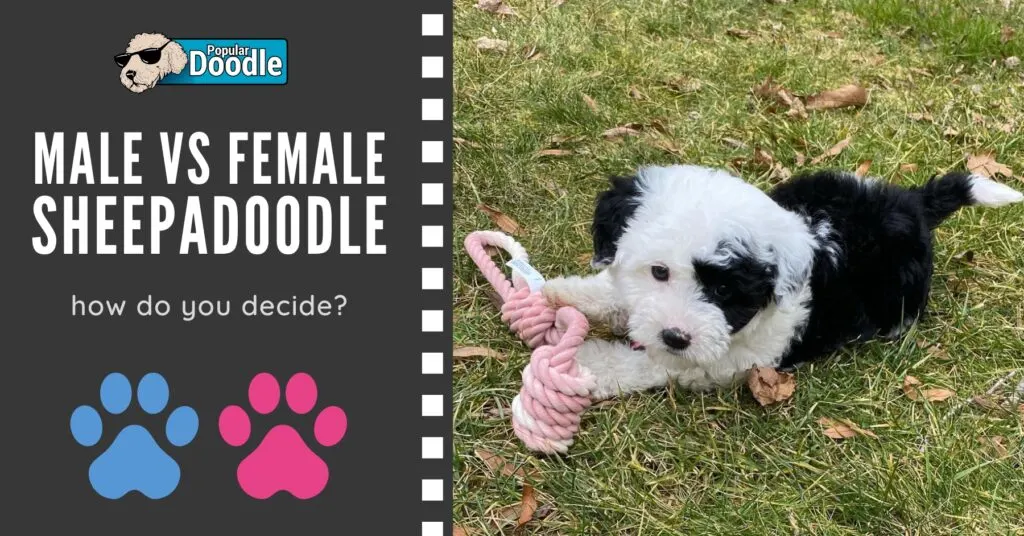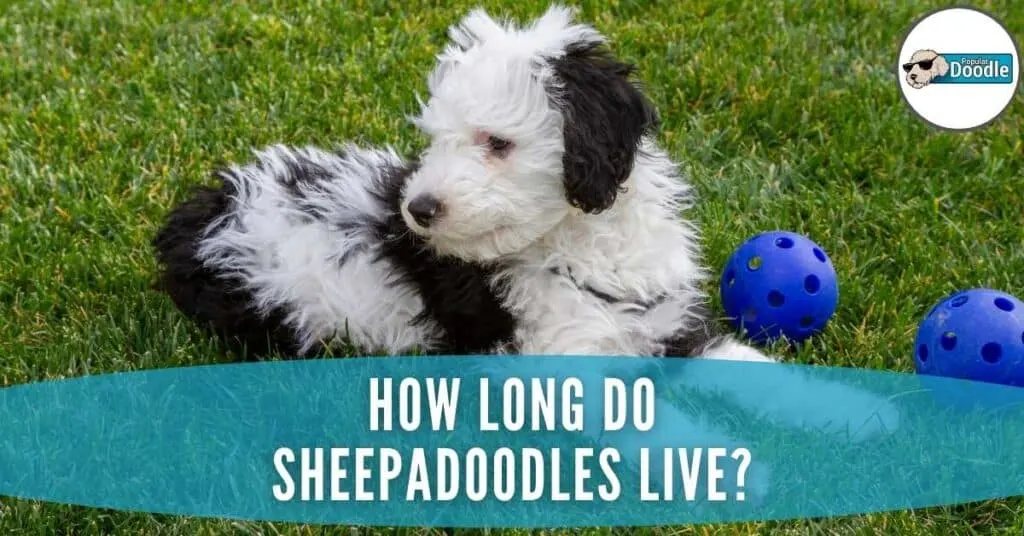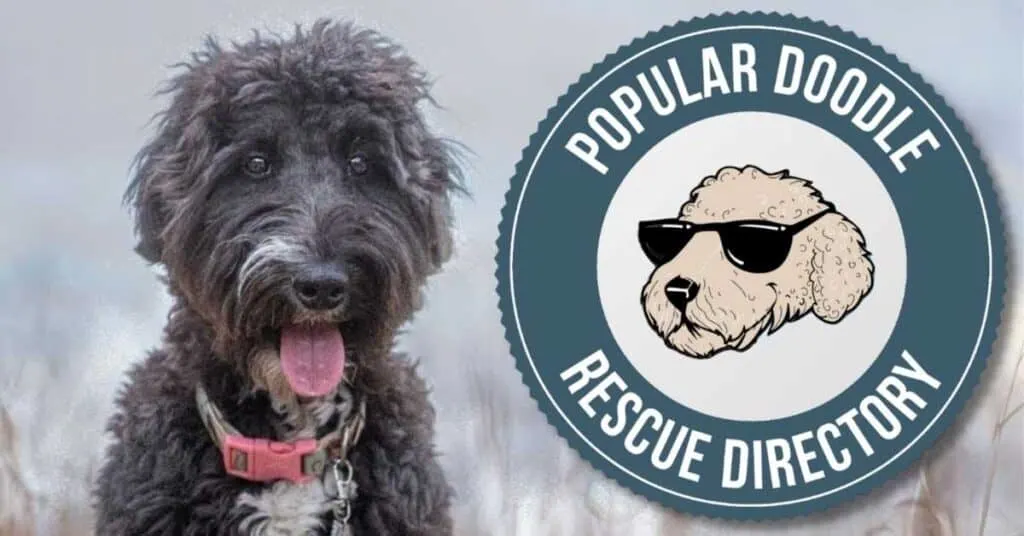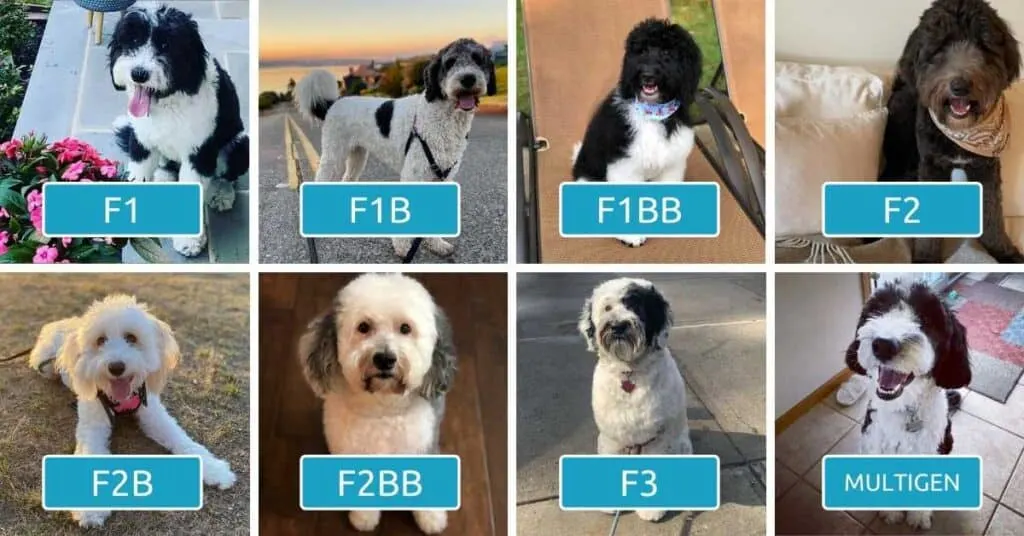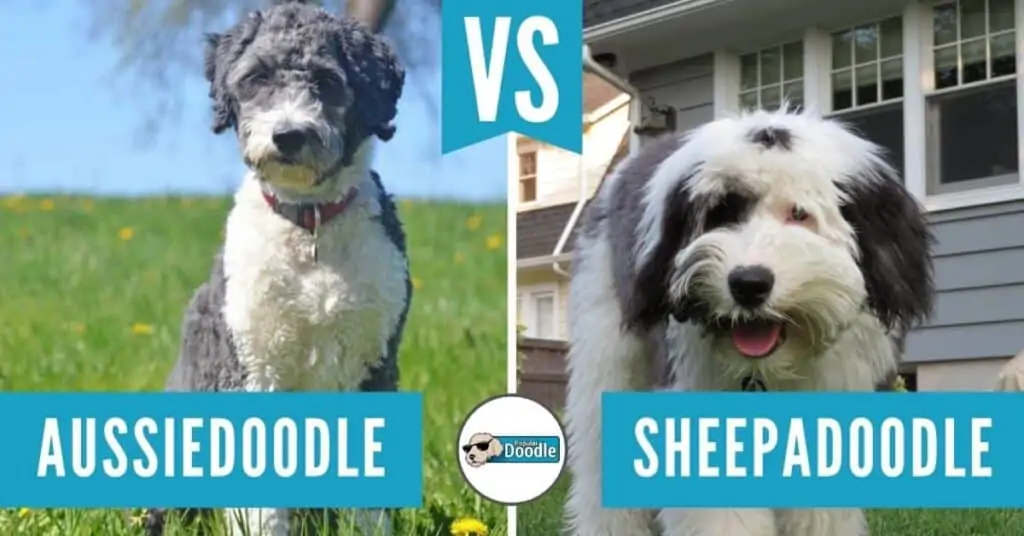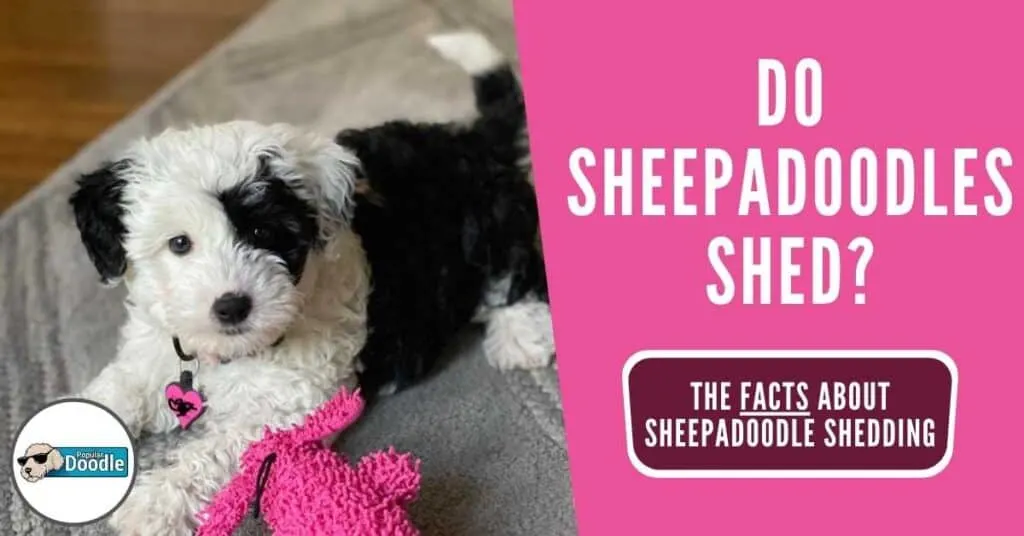
The question, “do Sheepadoodles shed?” comes up often when prospective pet owners are looking into the breed.
Myths and misinformation surrounding Sheepadoodles are common when it comes to shedding, but this article will help you filter truth from fiction and get all the information you need on your new Sheepadoodle puppy!
Do Sheepadoodles Shed?
Put simply, some Sheepadoodles shed while others don’t.
It can be hard to predict whether or not a Sheepadoodle will shed because they are a mix of a non-shedding breed, the Poodle, as well as a shedding breed, the Old English Sheepdog.
This DNA mix means you can’t guarantee that your dog will be completely non-shedding. Regardless, a mixed breed Sheepadoodle is much less likely to shed as much as a purebred Old English Sheepdog.
Some things that have a big impact on whether or not your Sheepadoodle will shed are their gettion (F1, F1B, etc.) as well as their parents’ genes.
This might sound complicated, but we’ll breakdown the difference between generations to give you a better idea of what to expect from your new dog.
Read ahead for the detailed answer to, “why do Sheepadoodles shed?” Along the way, we’ll provide some handy suggestions and product recommendations to help you deal with any amount of unwanted Sheepadoodle shedding.
Why Do Sheepadoodles Shed?
Sheepadoodles, like essentially any other dog, shed for a variety of reasons. There are four common factors that impact Sheepadoodle shedding that could influence how much hair your dog loses year-round.
Seasonal Sheepadoodle Shedding
It’s very common for dogs, even Sheepadoodles, to shed more in the spring and fall as the weather gets respectively warmer and cooler. Your dog’s coat is simply responding to the weather changes and making it so they stay comfortable year around.
Year Round Sheepadoodle Shedding
Shedding is a very common and normal process in many animals—even humans!
It happens as old cells die and are replaced with new ones. When hair cells die, that hair falls out to make room for new, healthy hair.
In general, shedding is a healthy behavior. The only time it could be a cause for concern is if it is happening in excess.
The reason that some dog breeds, like poodles, are known for their lack of shedding is because they have hair that is continuously growing. Their hair has a naturally longer lifespan that leads to very infrequent and minimal shedding.
Health Issues
It should be noted that shedding more than normal can be a sign of health problems in adult Sheepadoodles.
Excessive or sudden shedding is a common symptom when dogs are stressed, but could also indicate illnesses that require a vet visit, like cancer or parasites. These diseases can obviously lead to a shorter lifespan.
If you notice that your Sheepadoodle seems itchier than normal, is constantly licking, or in general seems to have skin irritation, you should make an appointment with your veterinarian.
Unexpected vet visits can be a real drain on your personal finances; that’s why I always recommend investment in good pet insurance to help you deal with any unforeseen pet medical bills.
When Do Sheepadoodles Shed Their Puppy Coat?
Puppies of any dog breed are born with a much softer, thinner coat than they end up with adults. As they age, their fur will become thicker and longer, and look more unique.
Sheepadoodles will most likely lose their puppy coat at around 5-12 months of age.
If you notice this with your young puppy, don’t worry! It’s like losing baby teeth, and isn’t a good indicator of future shedding. In fact, most likely won’t be able to tell how much your Sheepadoodle will shed until they’re about 2 old, around when their adult coat finishes growing in.
How Much Do Sheepadoodles Shed?
Like we said before, how much your Sheepadoodle sheds depends heavily on what generation they are. However, regardless of generation, there is no guarantee that your Sheepadoodle will be non-shedding.
If a breeder is promising you a non-shedding Sheepadoodle, they’re either being intentionally misleading, or don’t have a good grasp on what they’re talking about. In any case, this kind of behavior and false narrative is a big red flag.
It should be noted that some Sheepadoodles actually can be non-shedding, it’s just impossible to tell if a specific puppy will or won’t be until they’re fully grown.
Keep reading to learn more about Sheepadoodle generations and how they could impact your puppy’s coat.
Read More: Sheepadoodle Generations Made Easy (F1, F1B, F1BB, F2, F2B, F2BB, F3, Multigen)
F1 Sheepadoodles
The F1 generation of Sheepadoodle is typically going to be the most likely generation to shed.
F1 means that puppies of this generation are 50% Old English Sheepdog and 50% Poodle. Because of this, it’s hard to predict exactly what their coat will look like, as it can resemble one parent more than the other.
Because of the variance within F1’s, your Sheepadoodle could end up completely non-shedding or could shed as much as a typical Old English Sheepdog! In reality, you’ll probably end up with a dog that falls somewhere between these two options.
Basically, if you fall in love with an F1 Sheepadoodle, you should know that there is a good chance it will shed at least a little bit.
If shedding is a big deal breaker for you, it could be better to go for a different breed of doodle that is fully non-shedding (such as the Schnoodle or Poochon), or try a different generation of Sheepadoodle that has a lower probability of shedding.
F1b Sheepadoodles
The F1b Sheepadoodle is closer to a Poodle than the F1 Sheepadoodle is. This is because they have more Poodle DNA in them—theoretically making them 75% Poodle versus the F1’s 50/50 split.
So, will this make your Sheepadoodle shed less?
Well, F1b Sheepadoodles will most likely shed less than F1’s on average, but it is still not possible to be absolutely certain of this.
As long as you don’t severely struggle with allergies, the F1B is a good choice if you’re looking to minimize shedding.
However, if you’re looking for a dog with the highest probability of little to no shedding, you should look even further along the generational line.
Related: What is a Reverse F1B Sheepadoodle?
F1bb Sheepadoodles
An F1bb Sheepadoodle is as close as a Sheepadoodle can realistically get to being a full Poodle. In fact, their DNA theoretically split is made up of around 87.5% Poodle DNA.
This makes them a great choice for people with dog allergies as well as families who are certain they want a Sheepadoodle, but don’t want the shedding.
F2 Sheepadoodles
Next up is the F2 Sheepadoodle, which happens to be the worst option when talking about shedding alone.
This is because F2’s can result from a lot of different pairings, making the puppies’ coats extremely unpredictable and unique to not just each litter but each individual puppy.
However, you should remember that, just like with F1 Sheepadoodles, you can find a non-shedding F2 Sheepadoodle puppy—the odds just aren’t in your favor as much.
F2b Sheepadoodles
F2b Sheepadoodles, like their F1b counterparts, have more Poodle DNA than Old English Sheepdog DNA. They are also pretty similar in the amount they shed, on average.
F2b Sheepadoodles, are more likely to shed than dogs from the F2bb or F1bb generations, but they will usually shed less than F2 or F1 Sheepadoodles.
Managing Sheepadoodle Shedding
If you’re considering a Sheepadoodle, you have to accept that there is a good chance any puppy you get will shed at least a little bit.
Don’t worry! We’ve put together some tips for managing and minimizing Sheepadoodle shedding…
Bathe & Brush Often
Grooming is the obvious answer to keeping Sheepadoodle shedding to a minimum, as it helps loosen and remove dead hair in a controlled setting like a bathtub or backyard.
Brushing your dog often will prevent matting as well as spread natural, healthy oils across your dog’s skin. These two things greatly reduce shedding in Sheepadoodles.
Your Sheepadoodle will need to brushed at least once a week, but bushing them more often will greatly cut down on shedding in general.
Another great way to use take care of your dog and minimize shedding is to bathe them regularly. A monthly bath will promote general cleanliness and get rid of any excess hair that isn’t caught by a brush.
Unless your pup gets unusually dirty, they shouldn’t need baths too frequently to reap these benefits.
You may have been told that shaving down your dog completely can stop them from shedding. This isn’t true at all, even with Sheepadoodles.
Shaving them doesn’t actually tackle the problems that cause excess shedding, and while a nice trim can be good for them, a full shave is completely unnecessary.
Choose the Best Grooming Tools
Grooming your dog is ten times easier if you have the right tools at your disposal.
There are three products I always recommend for Sheepadoodle owners looking to minimize shedding: a slicker brush, a de-shedding tool, and a hydration focused, de-shedding shampoo.
A slicker brush is a must-have for any Sheepadoodles owner, no matter how much your dog sheds. While a lot of new owners will usually buy the cheapest option, I firmly believe that although a high-quality brush might cost a little extra, it is so worth it in the long run.
I love the Big G (Large), Big G (Medium) slicker brushes from Chris Christensen, as well as the Baby G brush if you have a Toy Sheepadoodle.
Now, let’s look at de-shedding tools. Not every Sheepadoodle sheds enough to make one of these a necessity, but they’re a great help for those dogs that do lose a little fur.
The Furminator De-shedding tool is a highly-rated option that is perfect for every kind of coat. Sheepadoodles will most likely need the long hair option in either the large size or small size.
Lastly, I love a good de-shedding shampoo, because it not only controls fur, but hydrates your dog’s skin, leaving them feeling refreshed.
The Burt’s Bees Shed Control Shampoo is all-natural, which means it has no harsh chemicals that could irritate your dog’s skin, and it’s puppy-safe!
Healthy Foods Are Key
Sheepadoodles, like any dog, require a balanced diet complete with necessary vitamins and nutrients. Without proper nutrition, your Sheepadoodle could experience excess shedding.
Most importantly, your Sheepadoodle needs a well-rounded dog food.
Some research also suggests that supplementary omega-3 fatty acids can promote healthy hair growth in dogs, among other benefits. Keep in mind, you should always talk with your local veterinarian before adding any new vitamins or supplements to your dog’s food.
It is also vital that you make sure your dog is getting enough to drink. Fresh water will keep their skin healthy as well as hydrated, which will help reduce shedding.
A good rule to follow is to make sure that every day your dog drinks about an ounce of water for every pound that they weigh.
Invest in a Vacuum Made Specifically for Dog Hair
Even if your Sheepadoodle only sheds a little, it can still be frustrating to find fur all over that house. No matter how much you brush or wash your dog, there will always still be a little left.
That’s why I recommend purchasing a vacuum made to deal with pet hair, like some of these high-quality Amazon options:
Purchase an Air Purifier
Pet allergies can really complicate owning your dream dog, but an air purifier can help! Air purifiers remove excess hair and dander from your home’s air, making you breathe a little easier.
Here are just a few of the best brands offered online for dog owners:
Sheepadoodle Shedding: The Conclusion
So, we’ve finally answered the complex question: “do Sheepadoodles shed?”
Basically, although some Sheepadoodles are less likely to shed, there really is no way to know for sure until the puppy has reached adulthood.
The best you can do is select the best generation for your family and then do your best to manage any potential shedding that occurs down the road.
If you do end up with a Sheepadoodle that’s prone to shedding, there are plenty of healthy things you can do to minimize fur flying around your house, and keep you and your pup as comfortable as possible!






